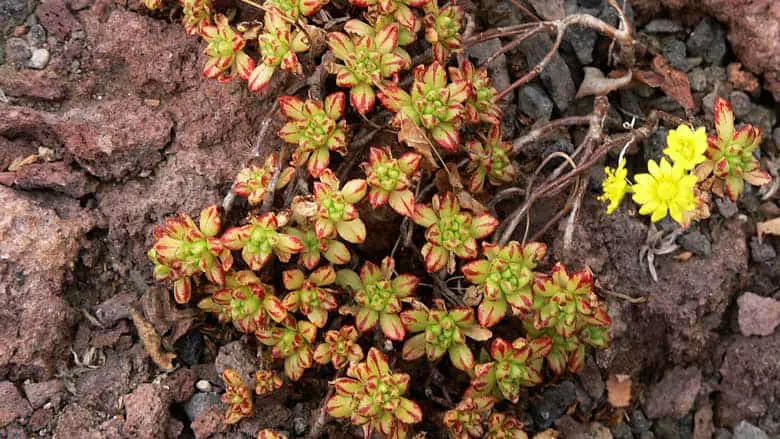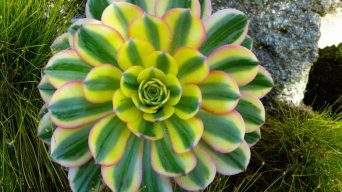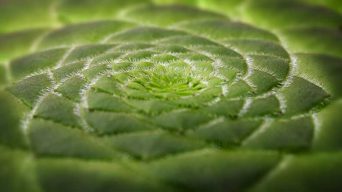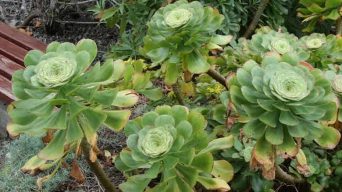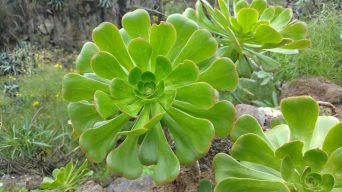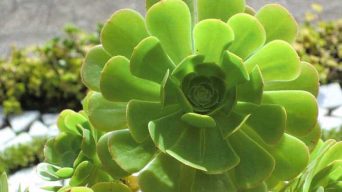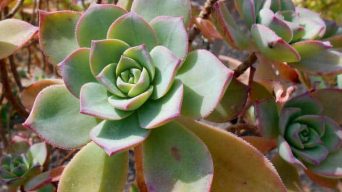The Aeonium sedifolium succulent plant is a popular and stunning houseplant.
It’s a hardy, drought-tolerant plant, making it a popular choice for indoor and outdoor landscapes.
If you want a unique addition to your home, this article will provide everything you need to know about caring for and propagating an Aeonium sedifolium!
Overview
| Family: | Crassulaceae |
| Genus: | Aeonium |
| Botanical Name: | Aeonium sedifolium |
| Synonyms: | Aichryson sedifolium, Greenovia sedifolia |
| Common Names: | Dwarf Aeonium |
| Origin: | Canary Islands of Tenerife, La Gomera, and La Palma |
| USDA Hardiness Zones: | 10a – 11b |
| Size: | 6 inches (15 cm) in height and width |
| Sun Exposure: | Full sun to partial shade |
| Water Needs: | Water thoroughly but infrequently |
| Soil Type: | Well-draining soil |
| Temperature: | 60° to70°F (15°-21°C) |
| Humidity Levels: | 60% |
The succulent Aeonium sedifolium, also known as Dwarf Aeonium, is a flowering plant in the Crassulaceae family endemic to Tenerife in the Canary Islands.
The Dwarf Aeonium has thin branching stems with small rosettes of fleshy green leaves with red stripes.
This small succulent plant grows up to 6 inches (15 cm) in height and width. It has rounded leaves up to 0.5 inches (1.3 cm) long and slopes upward at the rosette.
Aeonium sedifolium ‘Dwarf Aeonium’ plants produce small star-shaped yellow flowers in inflorescences that pop up at the tops of their leaves. These flowers bloom in spring.
How To Care for Aeonium Sedifolium’ Dwarf Aeonium’
Aeonium Sedifolium care isn’t a complicated process, but it does require a little bit of effort on your side.
The following are the main points to provide proper care for a Dwarf Aeonium plant.
Sun Exposure & Light Requirements
Aeonium sedifolium grows well in either full sun or partial shade.
When grown indoors, the Dwarf Aeonium will do best with a lot of bright light from an east or west-facing window for at least a few hours each day.
It should also get some natural sunlight during the middle of the day (within reason).
Aeonium sedifolium will show signs of sunburn if they receive too much direct sunlight.
New plants must be placed outside gradually over time so they become acclimated to their environment before being exposed to a lot of sun.
During the winter, aeonium sedifolium requires a little more light, with a few hours of direct sunlight coming in during the day.
Watering Requirements
The Aeonium sedifolium succulent should be watered only when the soil feels completely dry to the touch (about once a week); otherwise, it’ll rot away!
This succulent thrives in a dry environment and doesn’t require a lot of water like most other plants.
However, if you’re afraid it might not get enough moisture, it is an excellent way to water it by misting the leaves and stems.
And if you’re a little more daring, water them in the evening, then let them dry overnight before watering again in the morning. This will give your plants extra moisture without risking too much fungal growth or rotting from over-watering!
Even so, it is important not to overwater this plant; otherwise, the base of the stems will rot.
Soil Requirements
Aeonium sedifolium prefers light, well-drained soil that is not too rich in nutrients.
A generous amount of coarse sand or pumice is recommended to ensure good drainage, as this plant does not like wet feet!
It also needs a very porous potting medium, such as perlite mixed with some live sphagnum moss, for the roots to grow through.
A cactus potting mix with a unique sand, clay, and perlite blend is a good choice.
To avoid the plant being over-fertilized, it must only have a tiny amount (about a quarter) of compost or manure.
If succulents are grown in pots without drainage holes, they will not tolerate waterlogged soil for any time and should be left dry between watering.
Temperature and Humidity
To grow this succulent, the ideal temperature range is between 60-70 degrees Fahrenheit (15-21 C).
While Aeonium sedifolium does not do well in direct sunlight or extreme heat conditions, it will tolerate a few hours daily without any issues.
It is trickier to tell the ideal humidity range for this succulent because it depends on where you live.
If you are in a dry, desert-like climate, your best bet would be around 60% relative humidity year-round.
For more humid climates such as Florida or other southern states, 70% RH might suit better.
In any case, don’t let the air become too moist or stagnant. Ensure that there’s plenty of airflow within the enclosure at all times!
Fertilizing
For Aeonium sedifolium plants that are outdoors year-round or for indoor houseplants, fertilize every two weeks during the growing season (from early spring until late fall).
To fertilize Aeonium plants, you can use a water-soluble fertilizer diluted by half strength or a granular fertilizer diluted by half strength.
When fertilizing outdoors in a pot, mix the water-soluble or granular fertilizer into a cup of cool water and pour over the soil surface near plant roots.
For indoor houseplants, apply a liquid foliar feeder around the foliage.
Potting and Repotting
The Aeonium sedifolium ‘Dwarf Aeonium’ should not be repotted unless it is in a pot that is too small or the roots are growing out of its pot.
When you must repot your succulent plant, use a well-draining soil mix of sand and soil.
The best time for this is summer, when they’ve stopped actively growing.
Then place them into a pot with at least three times as much space for root growth than what was initially used before planting it back outside once more has been grown.
The Dwarf Aeonium’s roots will make a circle around the pot. When you remove it from its old pot to put it into a new one, gently break this circular root structure before putting it in, or you will damage your plant.
It is best not to repot an Aeonium sedifolium unless necessary, as they are slow plants with delicate roots.
Pruning
When a Dwarf Aeonium is in a container, you must trim it.
In general, you should trim the tips of your plants when they are about two-thirds grown and remove any dead leaves that have fallen off naturally throughout the year.
The Aeonium sedifolium can grow upwards, so adjusting its position every few weeks may help them maintain its shape better.
The tallest stems on this species often get a bit leggy at the end of summer because they’ve been overgrowing all season long.
A good prune before winter sets in can keep these from getting too unruly.
If your Aeonium has a flower stalk, prune that back to a few inches above the soil. The plant will be producing a new leaflet on this stem, which can help ensure you’re getting a lovely big bloom next year too!
Pests and Diseases
There is a limited number of pests and diseases that can affect Aeonium sedifolium plants.
One such pest is a mealybug which will eat the plant’s sap. The best way to eliminate a mealybug infestation is to wipe them off the plant with a cotton swab dipped in rubbing alcohol.
One disease commonly affecting Aeonium sedifolium is the “Rosacooty Foot” virus. It causes plants to lose their color and die, but you can eliminate this by removing all the foliage from a diseased plant.
In addition, you should keep your Aeonium sedifolium clean by wiping down leaves with a solution made up of one tablespoon of dishwashing soap mixed with two cups of warm water every week or so.
The best way to prevent pests and diseases from Aeonium sedifolium plants is to keep the plant healthy and clean.
How to Care for Aeonium Sedifolium in Winter
Aeonium sedifolium succulent care during winter is slightly different from growing Aeoniums during other times.
Dwarf Aeonium plants are tropical succulents tolerant to a range of temperatures.
But, they need a certain level of care if the plant encounters colder weather conditions.
The roots and leaves can come into contact with frost or ice if left outside during a cold snap.
Aeonium sedifolium should be brought indoors (or at least sheltered from extreme cold) when it becomes too cool for them outdoors.
The best way to prolong Aeonium sedifolium’s life is to keep them indoors.
If you live in a warmer climate, the Aeonium sedifolium succulent plant should easily survive a light frost or cold snap without additional care.
Aeonium Sedifolium plants don’t require too many hours of sunlight at home during a cold spell; about five hours is enough.
They do not tolerate much sun, so keep them out of direct sunlight as much as possible to maintain their color and prevent a burn.
You can continue to water the succulent plant during a cold snap regularly.
How To Propagate Aeonium Sedifolium’ Dwarf Aeonium’
The Aeonium sedifolium ‘Dwarf Aeonium’ can easily be propagated by seed or stem cuttings.
Seeds
The seeds of the Aeonium sedifolium ‘Dwarf Aeonium’ can be sown with a quality potting mix and then covered with a thin layer of vermiculite. The soil should not be too wet or dry to ensure it doesn’t rot away.
New plants need to get enough sunlight early to grow well, so they should ideally have a window facing southwest, as this will provide them with a lot more light than other windows.
In the meantime, artificial lights are also an option until they become strong enough outside.
Seeds need temperatures between 20°c – 30°c (68ºF – 86ºF) to germinate. This period can be anywhere from a few days to a couple of weeks.
Seeds may take up to a year to germinate, but if a seed has not grown within a month or two, it should be discarded.
As soon as the plant is large enough and grows new roots, you can pot it with a cactus mix soil. They will need more water to help them establish themselves.
Cuttings
The Aeonium sedifolium ‘Dwarf Aeonium’ can be propagated by stem cuttings. This method is much quicker; they will need much less maintenance than seedlings to grow well.
They should ideally be taken in spring or summer when the plant has gone dormant so that more time is available for them to take root before winter sets in again.
To create a cutting, use a pair of quality pruning shears to snip off a section from an older branch containing at least one leaf node (a point where leaves are attached).
The length of your new cutting should be at most 12cm (or about five inches), as this would make it difficult for it to sustain a lot of water.
The cutting should be allowed to callous for a few days before being planted in a pot with a cactus mix soil and watered well so that it starts growing new roots.
When Aeonium sedifolium ‘Dwarf Aeonium’ cuttings grow many new roots, you can transplant them into a bigger pot with a cactus mix soil.
Is the Aeonium Sedifolium Toxic?
The Aeonium sedifolium, as far as it is known, is not toxic to humans or animals.
However, Aeonium sedifolium is a succulent and stores water in the leaves, stems, roots, and flowers to survive under arid conditions.
This means if you touch a leaf of this succulent, it will have some liquid on it, which may cause irritation or a rash.
Final Thoughts
The Aeonium sedifolium ‘Dwarf Aeonium’ is a beautiful succulent plant that can be a great addition to any home garden.
It needs a little care, but not too much, and it’s easy to propagate them for you to have more plants.

